danbricklin.com/log
|
||
|
|
Starting May 19, 2005
Recording of the first part of the Mass Software OSS SIG meeting, Mass Software Council OSS SIG meeting, Back from Europe, Innovate! Europe '05, First Open Cellphone podcast available, Open Source SIG kickoff event at Mass Software Council, My podcasting setup, Third podcast interview, a visit to NASDAQ, and podcasting in business, Second podcast interview: Joel Spolsky, My new podcast
19May05-26Jun05
2005_05_19.htm
|
|
|
Recording of the first part of the Mass Software OSS SIG meeting [link]
I've uploaded an MP3 of the first hour of the meeting, the Software Licensing discussion. See the post on the SIG Blog for more information.
Mass Software Council OSS SIG meeting [link]
The meeting this morning was really good -- much better than I had even hoped for. The energy in the room was evident. You know something's right when dozens of the people in the "audience" participate (not just a few meekly asking questions), when most of the people there were really deeply involved in Open Source in some way (VPs, corporate counsels, entrepreneurs, developers, OSS evangelists), when a third of the people (even though we were mainly talking about business and legal things at this meeting) had written code in the past several months (including many lawyers!), and when one of the first comments was from Novell CEO Jack Messman who was just sitting in the audience with the rest of us and another participant (lively involved in give-and-takes with JBoss' Marc Fleury) was one of IBM's top OSS people who started on a panel but stayed for much more. Luckily we were audio taping the whole thing so others can share in some of this. We had the "organizing" power of a microphone that needed to be passed around (and we only had one of those) for the taping that kept things somewhat orderly. I frequently acted as "MC" and would run around with the one mike as people shot up their hands -- the running I hope kept the enthusiasm of comments going without dying out waiting for the slow arrival of the mike.
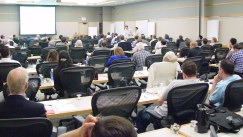 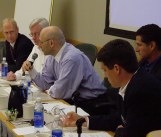 The view from the back of the comfortable room while Novell's Nat Friedman and Miguel de Icaza give some of what they've learned creating an Open Source project; R0ML talking on a panel with people from RedHat, Iona, Jaspersoft, and IBM
It's going to take a while to get write ups done and to get the audio cassettes turned into MP3s that you can listen to. Hopefully some of the bloggers who were there will post their observations soon. I've started a blog to hold that material and other ongoing things from the SIG. The blog is temporarily at oss-sig.softwaregarden.com (an easy place to move away from to a more permanent address without breaking links, I hope) and has an RSS feed.
A major goal of this meeting was to get the SIG going and give it some momentum. That goal was met quite well. There was lots of interaction, both public and private. There was lots of enthusiasm and lots of shared ideas for continuing and even some volunteers to help and to sponsor. And...the content of the sessions was really good, too. This was not "overview of what OSS is" stuff. There was good material here for people in the field and a feeling that others attending could understand you no matter how deeply you talked about something OSS-related. Hopefully we can run from this start and get a good ongoing group together that can help foster OSS in our locale and share what we can with the world.
Back from Europe [link]
I'm back from my Europe speaking/touring trip. I'm settling in, setting up some interviews to record and preparing for co-chairing the Massachusetts Software Council's Open Source SIG meeting Friday. (See my previous write-up.) If you are in the Boston area and are interested in Open Source this looks like it will be a good meeting. We've added some more participants to the business models session, including a company that Open Sourced some of their proprietary stuff (we'll discuss why) and Robert Lefkowitz. Hopefully we'll have some lively audience participation -- we're not having long speeches from the panelists.
Here are some random pictures and observations from my trip:
Segways are being used as rolling billboards in the old city in Barcelona. Antoni Gaudi designed some incredible structures.
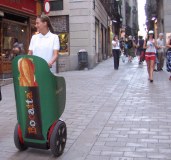 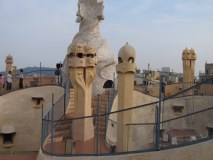 Segway as a billboard, roof of Casa Mila building designed by Gaudi
In the British Museum I got to see the Rosetta Stone, which I mention in my Copy Protection Robs The Future essay (so I now can add the picture to the essay since I own the photo rights), and stand in the Reading Room used by many famous people (H. G. Wells, Virginia Woolf, Karl Marx, Charles Darwin, Charles Dickens, etc.). I got to stand near or on the graves of Newton and Darwin (among many others) in Westminster Abbey.
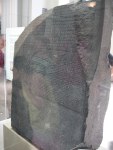 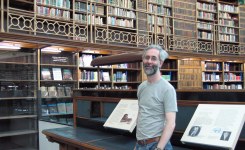 Rosetta Stone, Dan in Reading Room
The new keeps being built over the old. Later on people may discover new value in the old, but at the time it was assumed to be junk or something to be forgotten. For example, the Rosetta Stone was used in normal construction -- people routinely took pieces of old structures and graves and used them as building material. Modifying old structures is a key thing to ongoing development. Society is constantly evolving.
Spain has 90% cell phone penetration, and the average person gets a new one (with new features) every 8 or 9 months. I saw lots of people texting and fewer percentage talking than I see in the US.
London does indeed have cameras watching you all over the place:
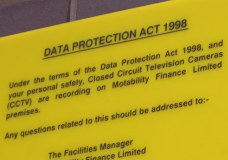 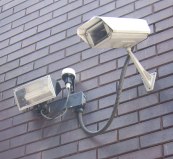 I'm reminded how innovative people are all over the world, and how innovative they've always been. The USA has no monopoly on it, we're just used to many innovative people immigrating here (which we're doing our best to stop in the name of "security", etc.). There are cultural barriers to widespread innovation in some countries (e.g., in the UK it used to be that a director of a company that went bankrupt couldn't be a director again for 10 years, failure or great success are both frowned upon in some countries like France), but that may be changing. Also, there are many multicultural people who don't have such problems who move from country to country and help get things going. China really gets it and is already a major force. Between China and India the US has its work cut out for it to stay at the top of the heap long-term.
The new thin, tiny digital cameras with large LCDs on the backs are a major win. I saw many people with them and used one myself. I took along just a new Canon SD500 (7.1 megapixel but I mainly shot 3mp) and a 1GB card -- it was great. For most people I'd recommend something like the SD400 Digital ELPH (5mp) which is even smaller and cheaper. Use the optical viewfinder to increase battery life -- I'd shoot all day without charging the battery (I ended up with well over 800 pictures). I switch between Automatic mode (which chooses the sensitivity and flash) and a Manual mode I set to 400 ASA (sensitive but a bit of noise in the picture) with no flash (great for museums and other indoor situations where flash should not be used). Digital is so much better than film for most people now because it holds so many pictures, lets you compose and share using the LCD (the value of the ability to share, even days later when you are recounting something to fellow travelers as you pull your camera out of your pocket, should not be underestimated), is so small so it fits in most pockets and purses, and lets you do video and/or sound recording when you need to (there is a wonderful fountain in Barcelona that dances to music -- still photos don't do it justice, flamenco dancing is hard to show without the sound and style of video, etc.).
The pictures on billboards show new cell phones that look just like these cameras -- big LCD on one side, lens on the other. They really might merge. Should I buy a Nokia camera or a Canon phone? Hmm.
Innovate! Europe '05 [link]
This week is the Innovate! Europe '05 conference in Zaragoza, Spain. I got to do a public kickoff keynote Monday night. I don't have time now to blog much about the whole experience, but I did want to put up a few pictures. The conference is being very well covered by some bloggers, both local (to Zaragoza) and more international. In fact, being one of the unusual guests (as a well-known techie from the USA) and being blogged about is strange to me -- I'm used to being a normal participant (like at PC Forum or BloggerCon) and perhaps being one of a few bloggers. Also, photos (good ones) and podcasting are becoming the norm, and I see that recordings of much of went on may be available online. It's like a huge spotlight was shined on what used to be a private affair. I have to think about this a bit more before blogging more about my feelings on this.
There is a contingent of bloggers here. I had seen some of their writings on the web telling people about the upcoming conference (I have Newsgator set to give me a feed for mentions of my name) and even read some of them by using AltaVista to translate the Spanish into English. It was cool to see a group of young people (being probably twice most of their ages, I can call them "young") all sitting there with their iBooks typing away while I spoke here in a place far from home. I sought them out at a reception after my speech and made sure I got a photo of some of the blogger attendees to the conference standing together:
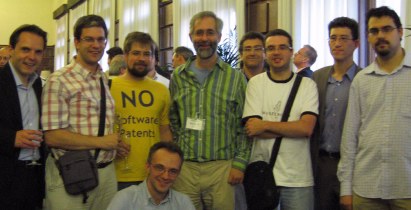 Bloggers in Zaragoza
We talked for a while as the bloggers were kind enough to use English while we talked about blogging and some of the questions I was asked about during my speech.
Notice the "No Software Patents" T-shirt. Software patents are a big issue here in Europe and questions about it come up frequently in Q&A's of various sorts.
Zaragoza is the 4th largest city in Spain, midway between Madrid and Barcelona. It is trying to encourage a high tech community in many ways, and having Chris Shipley and the Guidewire Group do this conference there is part of that work. The city people's can-do attitude and the nice environment the city provides were obvious, just like the enthusiasm of the bloggers that reminded me of the young "kids" I see at O'Reilly events.
Here are just a few other pictures from Zaragoza (it also has normal modern buildings like a regular city) to show you it's worth a visit even if only for touring:
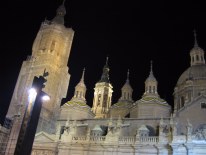 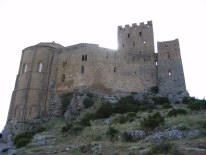 One of the two cathedrals seen at night, an 11th century castle nearby (Castillo de Loarre, seen in the movie "Kingdom of Heaven")
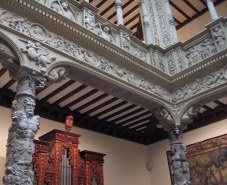 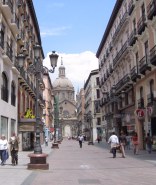 "Patio de la Infanta" (Goya Pictures Patio) where some of us learned about the city and its major savings bank, and one of the walkable ways near the other cathedral
First Open Cellphone podcast available [link]
DiamondCluster has posted the first, "kick off" podcast in the "Wavelengths" Open Cellphone series. (An Open Cellphone is one where the technology -- software, ports, etc. -- isn't controlled and dictated by the carriers, making it much more like a traditional personal computer.) The podcast is 35 minutes long and has John Sviokla of DiamondCluster, David Reed, and me discussing the reasons for an Open Cellphone, including some financial theory behind its value. We also talk about what future podcasts should cover. This is a hot topic (and it has gotten even hotter after we decided to do the podcast, including Steve Jobs talking about the topic at the D conference and Walt Mossberg then writing about it in his WSJ column last week).
To listen, look for links on the main page of the Open Cellphone podcast, podcast.diamondcluster.com, for the "List of Shows page" and the RSS feed.
I'm very excited about this series of podcasts. We have access to some heavy-duty thinkers in the area. David, for example, is working on cooperating radios and viral communications at the MIT Media Lab, gives speeches to the FCC, and was involved in the early specification of the Internet. DiamondCluster does lots of work with many telecom companies around the world, as well as some major industry suppliers, and will be able to coax some of the people there to participate. Please send us feedback and ideas (there's an email address on the podcast page).
I produced this podcast myself. In addition to doing the recording and the post-production, I also had an "intro" created for it. It seems that lots of podcasts have a distinctive audio introduction with perhaps music and effects, and often "theme music". After I played some introductions used by Adam Curry, ITConversations, Dawn and Drew, and others for John to get an idea about how this works, he decided that he wanted something for our podcast, too. He wanted something that evoked wavelengths (the working title of the podcast) and the future with an edgy sound to it. I suggested something like tuning in on an old radio. Doing special effects and writing music is not my strong suit, so I needed some help. I didn't want to just throw something together with royalty-free loops on Apple Soundtrack myself like I did for my other podcast. On the other hand, this is just a podcast, and only the first one of a series. Podcasts are often homemade, or at least somewhat low budget. It would be inappropriate to spend too much or work too hard on this.
I heard that one quick way to find a composer and/or performer is to post a job on the BerkleeMusic.com website. (Berklee College of Music is a Boston institution that trains students in all sorts of popular and commercial music areas. Lots of different musicians monitor the website.) I did that on a Friday morning and within a few hours of posting had responses from a variety of people, including Eric Peterson (a recent grad in film scoring), David Rosenbloom (a composer and software developer), Barak Shpiez, David Hab, and a few others (once I had a few that looked good I removed the job post).
The response from David Rosenbloom interested me the most because he knew who I was (he tells me he's a software developer in the online collaboration space) and had a very varied set of experience over the last couple of decades. He's a composer and performer, and has done work with video games, folk music, experimental music, jazz, rock, etc. He had an old website with samples that were both my style (folkie) and edgy (like John wanted).
We came to a simple deal and over the weekend David put together something to get our reaction. One of the samples he sent seemed to meet the needs as I saw them, and I put it together with a voice-over that I recorded as in intro and sent it to John. John liked it, as did some 20-somethings I tested it on, so there was no need to go back and forth improving it at this point. Maybe we'll work on it in the future.
The post-production of the podcast was a challenge. We did the recording like my other interviews, but we all called in to a conference call instead of a single person on the phone. Unfortunately, David's voice was often very soft, even with the auto-gain control of the Telos. I found that when I took the recording and used CoolEdit's dynamics processing I could boost the loudness of his speech even more. With dynamics processing you can make softer sounds louder and/or limit loud sounds from getting too loud. In addition, you can choose a frequency range in which to limit this processing. I limited the processing to 200Hz - 3,500Hz, which is around the range of a telephone call as provided by the Telos. Limited that way the higher frequencies of my breathing and other otherwise-quiet room sounds picked up by my microphone were not boosted. It still makes me sound like I'm breathing heavy sometimes, but overall it's much better than the original. In the future I guess I'll have to record my voice and the phone separately (which my setup can let me do) to make processing easier.
Open Source SIG kickoff event at Mass Software Council [link]
The Massachusetts Software Council has a few new special interest groups. One is an "Open Source SIG", and I'm one of the current leaders of the group, along with Bob Zurek, VP Advanced Technology of Ascential Software (now part of IBM), David Patrick, VP and General Manager - Linux, Open Source Platforms and Services Group of Novell, Tom Moran of Black Duck Software, and Peter Cormier, EVP Engineering of Red Hat.
We are kicking off the SIG with a "summit" meeting on Friday, June 24th, at the Babson Executive Conference Center. There are three sessions and a lunch with a keynote by JBoss CEO Marc Fleury. The sessions are: Open Source Licensing, Open Source Business Models and Strategies, and a technical discussion about how to create a successful Open Source project. We'll have senior people in the thick of Open Source issues from Red Hat, IBM, Novell and the Mono Project, JasperSoft, and others up on stage and I hope lots of interaction with people in the audience.
Check out the details on the Software Council website on the page for this event.
Seating is limited, so sign up in advance. The event is only $20, and I'm giving out complimentary copies of the evaluation version of my "A Developer's Introduction to Copyright and Open Source" video (they normally go for $29.95). I'm going to try to get this recorded for podcasting, but I can't be sure.
My podcasting setup [link]
As promised, I've written up the details of my podcasting setup and how I use it, including all the funny stuff I do to the recording to make it into a nice sounding, small MP3 file. This is not an "inexpensive as possible" setup. I'm using it for business and was willing to buy "good" equipment. Since I'm recording from phone lines, I wanted to make sure that it worked as well as possible but was flexible and under my control.
Thanks to my "PodGod", Doug Kaye, for help!
Read "My Podcasting Setup".
Third podcast interview, a visit to NASDAQ, and podcasting in business [link]
I just posted my third podcast. It's a 40+ minute interview with lawyer Lawrence Rosen. As before, we covered topics of interest to people involved with software licensing, Open Source, etc. My production quality is getting a bit better, I think, though I had the problem here that Larry's phone was very muted, so we switched to a speakerphone on his side which makes the sound a little choppy once in a while.
Learning about podcasting is helping me in other ways for me. Let me explain.
I do some work with DiamondCluster International, a consulting firm that, like me, mixes business and technology. I'm a "DiamondCluster Fellow", along with Gordon Bell, John Perry Barlow, and several other really cool people. Yesterday, I participated in a 45-minute technology panel discussion about "What's Hot?" at their Investor and Analyst's meeting in New York City. The panel consisted of one of their partners, a VP of Enterprise Technology Strategy and Planning of one of their clients, their Vice Chairman and Global Managing Director of Innovation and Research John Sviokla, and me. (There's a link to the many-hour webcast in the Investor section of their website, I believe.)
It just so happens that in morning before the meeting, DiamondCluster's CEO Mel Bergstein got to push the "opening button" of the NASDAQ stock exchange, celebrating 32 quarters as a public company. I didn't know about this in advance, and didn't even bring my good camera, but went along with a dozen or so DiamondCluster people for fun. I took some photos with my Treo 600. Since the NASDAQ is computerized and doesn't have a trading "floor", the place to do this is really just a TV set in Times Square with studios for the financial news networks. The yelling and screaming when Mel pushed the button was just us and the camera crew. Actually, the cameras are all fixed, and there's barely anybody there.
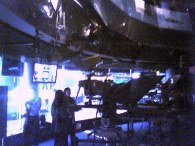 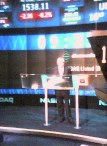 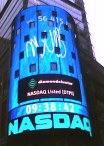 The window in the studio facing out to Times Square and a few of the many, many fixed TV camera and the network booths above; DiamondCluster CEO Mel Bergstein giving a short talk in front of the huge wall of monitors 10-20 feet away; Mel's signature on the tower visible in Times Square on their super-size screen
After the button was pushed at 9:30 am, two business reporters came out to give their "opening bell" reports. This was fascinating. They both had their long presentations to give, which they did in quick, unhesitating voices -- not rambling like many of our podcasts. Really tough to do. And...they gave them at the same time. It was incredible. I don't know how they do it. Standing just a few feet apart, they talk to their audiences as if they were the only person in the room, rattling off fact after fact, maybe glancing down once in a while at some papers they hold, but with the teleprompters turned off. All the while they may be watching the clock and the monitor to see their position on TV. They must have very directional microphones. Or, maybe, the noise we hear in the background that sounds like they are in a busy room is really just the two of them reporting at once... It was fun to see pros at work.
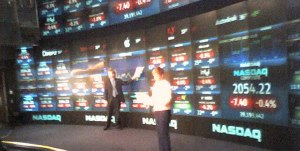 Two reporters simultaneously reporting the state of the market
So, how does all this relate to my podcasting? On the way back from New York, John Sviokla and I sat next to each other on the train. I let him listen to a sampling of some podcasts to understand the wide range of styles -- Dawn and Drew, Gillmor Gang, Adam Curry (with promos and a soundseeing tour), mine, etc. We then discussed how we could do one on behalf of DiamondCluster that would be of interest to techies and their target audience of CTOs, CIOs, and others. He committed to start. We'll be recording the first one next week and hopefully get it posted soon thereafter. In the spirit of the events I go to as a Fellow, and in homage to my favorite, the old Gillmor Gang, we'll have discussions on a topic as a small group (probably 3-4 on a conference call). The first one will be a follow-on to the write-up John had last Monday in the Wall Street Journal (page R6) about the "Open Cellphone". He's quoted there as saying: "The phone companies cannot possibly market all the options that people might come up with. If they open the device, then the market of new adopters can discover the most popular combinations, and then the big guys can pick the popular things and merchandise them extensively." There's enough on that topic for many podcasts, and he has access to lots of interesting people to discuss it, with all sorts of viewpoints.
For me, I now have a consulting gig that involves podcasting. Cool! As I said before, podcasting is like blogging in that it fits in with the marketing for "experts". Here the "expert" is a public company (DiamondCluster). John, who was a Harvard Business School professor for many years before joining DiamondCluster, is already thinking of other applications.
Second podcast interview: Joel Spolsky [link]
I've lined up a few interviews to start my podcast "career". The second show (now posted) is an interview with developer, blogger, etc., etc., Joel Spolsky of Joel On Software fame.
I'm slowly learning the technical details of podcasting, especially phone interviewing. Getting all of the sound levels right is tough. Like spelling errors and bad typography, bad sound can get in the way (distortion, poor compression, too many echoes, widely varying levels, etc.). We learned with blogging to have a minimum level of "polish" that doesn't get in the way of a normal message. A strong message can overcome poor use of a medium, but with blogging and podcasting it's hard to have a consistently strong message (which is often why we depend on others to find the "good stuff" for us). I'm trying to make sure that I'm at that reasonable level of sound polish compared to what our ears are used to. With poor typography and poorly designed fonts (which most of us don't see or use) reading is made harder on the eyes. Likewise, poor sound of various sorts can make listening harder. People work really hard to make their blog's template look good, or get more visually talented friends to help them (especially with Photoshop), and it has helped make blogging more acceptable. That was one of the nice things about tools like Blogger, etc., that came with some good templates so by default you looked OK and could personalize with one JPEG from a friend. I don't know if podcasting tools are there yet. Luckily, some of the early podcasters have some audio experience (Doug Kaye, Adam Curry, etc.) and others of us copy them.
My new podcast [link]
I've finally started my own podcast, "Dan Bricklin's Software Licensing Podcast". It will be a series of interviews and perhaps other material that should be of interest to people who care about the legal and managerial aspects of software licensing in general, Open Source licenses in particular, and who knows what else. I've posted the first show, an interview with Commonwealth of Massachusetts Information Technology Division General Counsel Linda Hamel. She tells us about the switch from all-proprietary software at the State to also including Open Source software in the mix as seen by a lawyer previously unfamiliar with Open Source. I have a few more interviews lined up and should release them over the coming days and weeks.
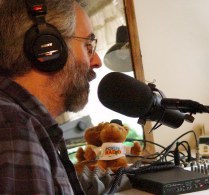 What I looked like recording the podcast
The podcasts are "sponsored" by my little company, Software Garden, so you might call them "peapodcasts" -- in honor of the Software Garden logo. In fact, the serving of the MP3 files is from the domain "peapodcast.com", but the main podcast page is www.softwaregarden.com/podcast.
 Software Garden logo
In the coming days or so I'll also write up the technical details of what I'm using (equipment, software, etc.). Today I just want to announce it and give some business background.
Why did I start podcasting now? What do I expect to get out of it? Here are some answers:
As regular readers here know, I've recently released a training video to introduce developers to the basics of copyright law, software licensing, open source, and how to bring legal representation into the development process. A challenge I have is figuring out how to market the video. The most likely purchasers (or specifiers) of the video are corporate lawyers and executives concerned with software licensing issues. These people are not the same as those that are the target for watching the video -- they already know an awful lot about what the video covers. These people also are probably not the type who normally follow my blog or the blogs of others who usually point here. I need another means to make them aware of what I have to offer.
In the past with products (like in the 1980's with Dan Bricklin's Demo Program) I advertised in various periodicals with pretty good success. At Trellix we had a dedicated sales force calling upon potential customers (hardware manufacturers and then ISPs). That's all very expensive. For ListGarden, my RSS creation program released under the GPL, some mentions here plus the fact that it's under GPL and free of charge (and that people like it) has led to wide adoption with little cost to me. It's reviewed and mentioned in lots of places and shows up in Google well. The downloads keep happening with little effort (or cost) on my part. (A new, upgraded version of ListGarden is in the works that supports podcasting better -- I'm using an alpha release for the podcast as part of doing QA.) The video, though, is not free of charge and loses some of the marketing help an Open Source program gets automatically.
During beta testing of the video I heard repeated requests from lawyers and others who wanted me to get them more material aimed at them and not at the developer viewers. I got requests to tell them what I've found talking to others, both lawyers and non-lawyers involved in software licensing. Apparently these people are too busy doing their job and don't have time to go around and schmooze with others in the field. I thought of podcasting as a way to let them hear what others had to say. This would give me a great excuse to start podcasting (I like to learn about new technologies and media by getting my hands dirty trying things).
So here I have what I hope is a good business model for podcasting: Getting awareness in an area in which I wasn't that well known among potential purchasers of a product. A vehicle for "sponsorship" advertising ("...brought to you by Software Garden, producer of the training video..."). I get to build up my credibility and stature in a target market, create awareness of a product, and do good for the listeners, all at once. This is similar to the "business model" of blogging for many of us "experts". And the costs, even going pretty much almost first-class (as you'll see I did), are much less than advertising and much, much less than direct sales. We'll see how it works.
|
||
|
© Copyright 1999-2018 by Daniel Bricklin
All Rights Reserved.
See disclaimer on home page.
|
||